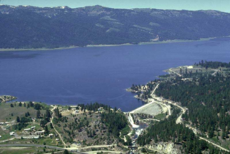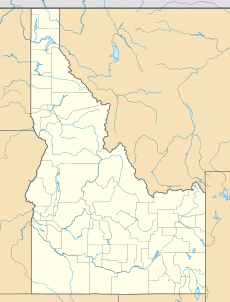Lake Cascade
| Cascade Dam | |
|---|---|

Cascade Dam
|
|
|
Location in Idaho
|
|
| Country | United States |
| Location | Valley County, Idaho |
| Coordinates | 44°31′26″N 116°03′04″W / 44.524°N 116.051°WCoordinates: 44°31′26″N 116°03′04″W / 44.524°N 116.051°W |
| Purpose | Water storage |
| Construction began | 1942, 1946 |
| Opening date | 1948 |
| Owner(s) | U.S. Bureau of Reclamation |
| Dam and spillways | |
| Type of dam | Zoned earthfill |
| Impounds | N. Fork Payette River |
| Height | 107 ft (33 m) |
| Length | 785 ft (239 m) |
| Width (base) | 45 ft (14 m) |
| Reservoir | |
| Creates | Lake Cascade |
| Total capacity | 693,100 acre feet (854,900,000 m3) |
| Catchment area | 620 sq mi (1,610 km2). |
| Surface area | 47 sq mi (122 km2) |
| Normal elevation | 4,828 ft (1,472 m) |
Lake Cascade (formerly "Cascade Reservoir", also formerly known as Payette Lake "The Mile High Playground" ) is a reservoir in the western United States, on the North Fork of the Payette River in Valley County, Idaho. Located in the Boise National Forest, it has a surface area of 47 square miles (122 km2), and is the fourth largest lake or reservoir in the state. The closest cities are Cascade, Donnelly, and McCall, all in the Long Valley of Valley County.
Following a delay due to World War II, the earthen dam was built by the Bureau of Reclamation, and completed in 1948. The term "Lake Cascade" came into common use in the 1990s, with the federal name change made in 1999.
The lake contains perch, trout, smallmouth bass, Kokanee salmon, and Coho salmon for anglers and there is a beautiful winter ice fishing season. Lake Cascade State Park has several units around the lake.
In 2003 the Idaho Department of Fish and Game (IDFG) proposed draining Lake Cascade to facilitate the removal of pikeminnow and the addition of sport fish, such as perch. Pikeminnows are a problem in Lake Cascade because they are predators that live up to 15 years and compete for food stocks. Issues involved in mitigating damage during the lowering of the lake level include maintaining an adequate supply for irrigation, providing a steady stream for power, maintaining salmon flow augmentation, and other water rights. The U.S. Bureau of Reclamation manages the reservoir and estimated the draining could take place over the course of a year at a cost of $100,000 to $300,000. The U. S. Bureau of Reclamation withdrew its application for an Environmental Impact Statement studying the drawdown citing "that the draining of Lake Cascade is not a viable option for sport fish restoration."
...
Wikipedia

